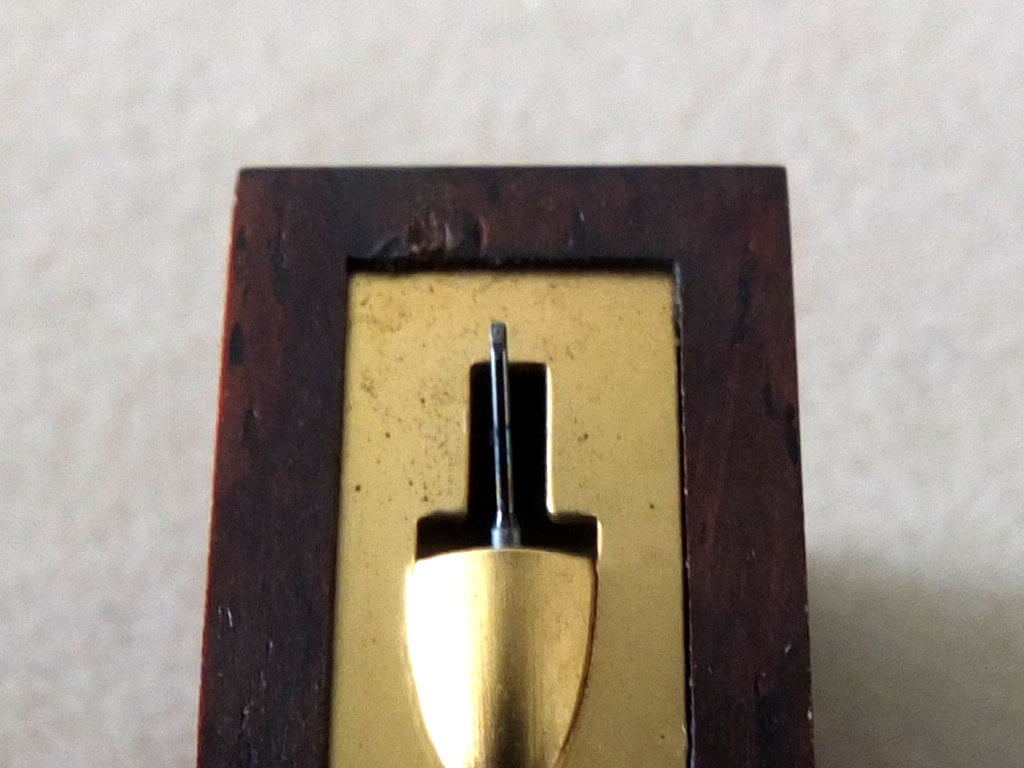It’s the time of year for saving money!
In the last installment, Part 6 of this continuing series about phonograph records and the equipment for playing them, I wrote primarily about motion as related to phono playback, talking about how the motion of the turntable provides energy for the recorded groove to wiggle the stylus of a phono cartridge; how the motion of the stylus is applied to produce output to be fed into an amplifier so that it can be sent to speakers for us to hear; how the more motion there is of the stylus of any kind of cartridge, the greater its output will be; and, finally, because a “magnetic” cartridge – the current standard in whatever form – has so much less output than its crystal or ceramic predecessors, that magnetic cartridge designers usually design their products to have a “cantilever”, and sometimes design that cantilever to be a “Class 1” lever that will, by having its fulcrum (the pivot) closer to the stylus than to the signal-generating parts also attached to it, multiply that motion to give higher output.
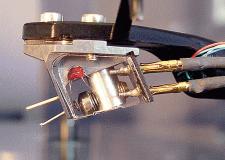 The greater the desired increase in output, the greater must be the difference in distance between the two ends of the cantilever and its pivot. The greater the required distance differential, the longer the cantilever may need to be. The longer it is, the greater will be the possibility of flexure, regardless of the material it’s made of or its particular structural design, and any flexure at all will result in distortion of the output signal. That’s why so much of Part 6 was about cantilever materials and design.
The greater the desired increase in output, the greater must be the difference in distance between the two ends of the cantilever and its pivot. The greater the required distance differential, the longer the cantilever may need to be. The longer it is, the greater will be the possibility of flexure, regardless of the material it’s made of or its particular structural design, and any flexure at all will result in distortion of the output signal. That’s why so much of Part 6 was about cantilever materials and design.
The pivot – essential for any kind of a lever – is, as I also said in Part 6, another potential source of problems. While designing and building a “single plane” pivot out of “hard” ( non-flexing) materials for cartridges to play monophonic (“monaural”) recordings is fairly easy, the fact that stereo recordings are cut as two separate channels of information, both horizontally and vertically interacting with each other at a total included angle of 90° (45° + 45°), makes for much more of a problem: Unless the pivot (any pivot, either for mono or stereo) can serve as a set-position fulcrum, allowing the cantilever to move only in the direction and only to the degree required by the movement of the stylus in the groove, there will be distortion of one kind or another. And unless the clearances for motion between the cantilever and the pivot are sufficiently “tight”, not only may there be spurious motion, but there may actually be “chatter” as the pivot (if it’s of a hard material) and the cantilever bang together in uncontrolled motion. This will at least result in a kind of distortion, and may even become an audible part — an extra sound – in the cartridge’s output. One commonly used solution to the problems both of providing controlled movement in multiple directions and guarding against pivot chatter is to design the pivot as a collar of highly compliant plastic. This works well, but to the degree that the plastic allows (by stretching, flexing, or compression) movement other than exactly in accord with the movement of the stylus, it remains less than perfect.
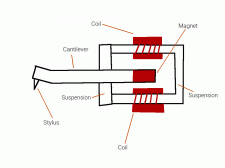 Another source of “extra sound”, and of distortion is resonance, and it can it can occur all throughout the phono playback system. One of the reasons that Joe Grado, the inventor of the moving coil phono cartridge, may have had for never actually using that technology in any of his commercial products may have been the moving coil cartridge’s characteristic rising frequency response due to resonances in its generating system.
Another source of “extra sound”, and of distortion is resonance, and it can it can occur all throughout the phono playback system. One of the reasons that Joe Grado, the inventor of the moving coil phono cartridge, may have had for never actually using that technology in any of his commercial products may have been the moving coil cartridge’s characteristic rising frequency response due to resonances in its generating system.
As I’ve said before, everything (every material object) has a “fundamental resonant frequency” at which it will vibrate in response to any stimulus (Any source of external resonant energy of any frequency). It also has “harmonics” that are multiples of that fundamental resonance frequency and, when stimulated (when energy is applied, as by moving a stylus through a record groove, to cite just one of a truly infinite number of examples), it will vibrate at those frequencies, too.
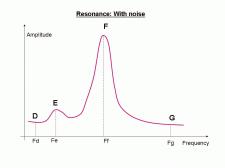 The resonant frequencies of any object, whether fundamental or harmonic, depend on its shape, its total mass (how much “stuff” it’s made of at the atomic level) and whether and to what degree it’s under tension (as in a guitar or violin string). How much it will vibrate at any one or all of its resonant frequencies will depend on just two things: the “strength” (total effective energy) of the stimulus and how close the frequency of the stimulus (even a single pulse has a “frequency”) is to the resonant frequencies of the object being stimulated: the closer the frequencies are to each other, the greater the effect of the stimulus will be and the more resonance (vibrational movement) will be produced.
The resonant frequencies of any object, whether fundamental or harmonic, depend on its shape, its total mass (how much “stuff” it’s made of at the atomic level) and whether and to what degree it’s under tension (as in a guitar or violin string). How much it will vibrate at any one or all of its resonant frequencies will depend on just two things: the “strength” (total effective energy) of the stimulus and how close the frequency of the stimulus (even a single pulse has a “frequency”) is to the resonant frequencies of the object being stimulated: the closer the frequencies are to each other, the greater the effect of the stimulus will be and the more resonance (vibrational movement) will be produced.
It’s all about movement – when an object vibrates, it moves; and when the movement we’re talking about happens to be done by the cantilever/stylus/pivot/generator assembly of a phono cartridge, the whole purpose of which is to turn movement (of the stylus in the spinning groove) into electricity, it can create problems.
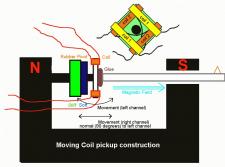 With any phono cartridge, the parts, whether moving or not, are quite small and, when the stylus is in the groove, the cantilever (at least the part between the stylus and the pivot) is under tension. Both of those are contributors to a high resonance frequency. With moving coil cartridges having a pair of teeny-tiny little coils being wiggled in a magnetic field to break magnetic force lines to create its output, the resonance can be even higher: Those tiny coils, because of their size, mass, and shape have a very high fundamental resonance frequency (often in the range of 35kHz or thereabouts). When a record is played, the frequency recorded in the groove acts not only to move the stylus as necessary for playback, but to stimulate the natural resonances of the cartridge and its generator elements. As the recorded frequency increases to more closely approach the cartridge’s natural resonant frequencies, the resonance (stimulated movement) of those elements adds to the signal energy from the groove to result in increased output, an often perceivably “bright” sound, and sometimes even audible distortion.
With any phono cartridge, the parts, whether moving or not, are quite small and, when the stylus is in the groove, the cantilever (at least the part between the stylus and the pivot) is under tension. Both of those are contributors to a high resonance frequency. With moving coil cartridges having a pair of teeny-tiny little coils being wiggled in a magnetic field to break magnetic force lines to create its output, the resonance can be even higher: Those tiny coils, because of their size, mass, and shape have a very high fundamental resonance frequency (often in the range of 35kHz or thereabouts). When a record is played, the frequency recorded in the groove acts not only to move the stylus as necessary for playback, but to stimulate the natural resonances of the cartridge and its generator elements. As the recorded frequency increases to more closely approach the cartridge’s natural resonant frequencies, the resonance (stimulated movement) of those elements adds to the signal energy from the groove to result in increased output, an often perceivably “bright” sound, and sometimes even audible distortion.
It’s not just high frequency resonances that can cause problems, either. Lower frequencies, as from the acoustic feedback induced when a recording is played too loud or when the turntable isn’t properly suspended or solidly-enough mounted – or even when we walk too close to the turntable on an “other-than-solid” floor — can also create changes in what we hear, even if they’re not forceful enough to cause the stylus to skip out of the groove.
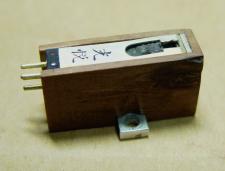 And it’s not just the generator elements of the cartridge that may affect or be affected by resonance: A good many cartridges – the Koetsu Rosewood and the Kiseki Lapis Lazuli, to name just two examples – are housed in “shells” or cartridge bodies made of unusual, exotic, and sometimes viciously expensive materials. Because none of these are electrical conductors or are part of the generator apparatus for the cartridge, I can only believe that they are used just to make the cartridges more expensive and appealing to a luxury high-end market or, more likely, because the resonance effects of the materials; their size and shape; and the way the generator elements are mounted to them add something to their sound that people like and are willing to pay for.
And it’s not just the generator elements of the cartridge that may affect or be affected by resonance: A good many cartridges – the Koetsu Rosewood and the Kiseki Lapis Lazuli, to name just two examples – are housed in “shells” or cartridge bodies made of unusual, exotic, and sometimes viciously expensive materials. Because none of these are electrical conductors or are part of the generator apparatus for the cartridge, I can only believe that they are used just to make the cartridges more expensive and appealing to a luxury high-end market or, more likely, because the resonance effects of the materials; their size and shape; and the way the generator elements are mounted to them add something to their sound that people like and are willing to pay for.
I’ll have more on resonances and other things next time. See you then!
